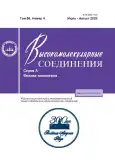Influence of Deformation of Metal Matrix on the Mechanical Properties of Poly(Ethylene Terephthalate) Inside It
- Авторлар: Kechek’yan A.S.1, Bazhenov S.L.2, Monakhova K.Z.1, Kurkin T.S.1
-
Мекемелер:
- Enikolopov Institute of Synthetic Polymeric Materials, Russian Academy of Sciences
- Semenov Federal Research Center for Chemical Physics, Russian Academy of Sciences
- Шығарылым: Том 65, № 4 (2023)
- Беттер: 275-284
- Бөлім: СТРУКТУРА И СВОЙСТВА
- URL: https://journals.rcsi.science/2308-1120/article/view/135312
- DOI: https://doi.org/10.31857/S230811202370058X
- EDN: https://elibrary.ru/PYLKEX
- ID: 135312
Дәйексөз келтіру
Толық мәтін
Аннотация
The influence of different types of deformation of the metal matrix on mechanical behavior of the amorphous PET film upon its transverse compression in the ductile metal matrix has been investigated. Three deformation modes have been probed. In the first case, a disc-shaped polymer specimen has been put between two 5 mm thick discs of the lead–tin alloy and squeezed in the press. In the second and the third cases, planar elongation has been performed in the so called “dead channel”, i.e., the channel with fixed side walls, the film being elongated due to decrease in the width or thickness, respectively. The plots of true yield stress at different draw ratios have formed a common master curve. At high total draw ratio Λ, the true yield stresses have been close for the considered three types of drawing in the metal. At the draw ratio Λ > 2.6, the neck has not appeared, and the specimen has been deformed uniformly. When the film in the channel is elongated due to the decrease in thickness at constant width, the specimen width has been mainly decreased during subsequent elongation in the testing machine. When the film in the channel is elongated due to the decrease in width at constant thickness, further elongation has mainly led to the decrease in the specimen thickness. The true stress Σ has been expressed as Σ = Σ0 + KΛ3, with K being a constant. Deformation of the polymer in the channel occurred with the formation of shear bands. At the preliminary draw ratio Λ = 1.82, the bands have been oriented at the angle 21.5° with respect to the stretching axis. The planar elongation has led to abnormally strong deformation softening of the polymer. The drawing has been accompanied by an increase in the elasticity modulus of the polymer. The obtained results have suggested that the macromolecules orientation is the main reason for strain hardening of the polymer.
Авторлар туралы
A. Kechek’yan
Enikolopov Institute of Synthetic Polymeric Materials, Russian Academy of Sciences
Email: sergey.l.bazhenov@gmail.com
117393, Moscow, Russia
S. Bazhenov
Semenov Federal Research Center for Chemical Physics, Russian Academy of Sciences
Email: sergey.l.bazhenov@gmail.com
119991, Moscow, Russia
K. Monakhova
Enikolopov Institute of Synthetic Polymeric Materials, Russian Academy of Sciences
Email: sergey.l.bazhenov@gmail.com
117393, Moscow, Russia
T. Kurkin
Enikolopov Institute of Synthetic Polymeric Materials, Russian Academy of Sciences
Хат алмасуға жауапты Автор.
Email: sergey.l.bazhenov@gmail.com
117393, Moscow, Russia
Әдебиет тізімі
- Allison S.W., Ward I.M. // J. Appl. Phys. 1967. V. 18. P. 1151.
- Broutman L.J., Patil R.S. // Polym. Eng. Sci. 1971. V. 11. P. 165.
- Ward I.M. The Mechanical Properties of Solid Polymers. New York: Wiley, 1984.
- Roesler J., Harders H., Baeker M. Mechanical Behavior of Engineering Materials. New York: Springer, 2007.
- Osswald T.A., Menge G. Materials Science of Polymers for Engineers. München: Hanser Verlag, 2003.
- Van Melick H.G.H., Govaert L.E., Meijer H.E.H. // Polymer 2003. V. 44. P. 3579.
- Govaert L.E., Van Melick H.G.H., Meijer H.E.H. // Polymer 2001. V. 42. P. 1271.
- Точин В.А., Щупак Е.Н., Туманов В.В., Кулачинская О.Б., Гай М.И. // Механика композит. материалов. 1984. № 4. С. 635.
- Bazhenov S., Li J.X., Hiltner A., Baer E. // J. Appl. Polym. Sci. 1994. V. 52. № 2. P. 243.
- Bazhenov S.L. // Polym. Eng. Sci. 1995. V. 35. № 10. P. 813.
- Nielsen L. Mechanical Properties of Polymers and Composites. New York: Marcel Dekker, 1974.
- Bazhenov S.L., Grinev V.G., Kudinova O.I., Novoksho-nova L.A. // Polymer Science A. 2010. T. 52. № 5. C. 549.
- Considere M. // Die Anwendung von Eisen und Stahl bei Constructionen. Vienna: Verlug von Carl Gerolds Sohn, 1888.
- Haward R.N. // J. Mat. Sci. 2003. V. 38. P. 2155.
- Haward R.N., Thackray G. // Proc. Roy Soc. London. A. 1967. V. 302. P. 453.
- Эшби М., Джонс Д. Конструкционные материалы. Полный курс. Долгопрудный: Интеллект, 2010.
- Samios D., Shinichi T., Denardin E.L.G. // Int. J. Plasticity. 2006. V. 22. № 10. P. 1924.
- Efimov A.V., Bazhenov S.L., Tyun’kin I.V., Volynskii A.L., Bakeev N.F. // Polymer Science A. 2013. V. 55. № 12. P. 721.
- Bazhenov S.L., Efimov A.V., Bobrov A.V., Kechek’yan A.S., Grokhovskaya T.E. // Polymer Science A. 2015. V. 57. № 3. P. 285.
- Bonart R. // Kolloid-Zeitschrift und Zeitschrift für Polymere. 1969. V. 231. P. 438.
- Bartczak Z. // J. Appl. Polym. Sci. 2002. V. 86. P. 1396.
- Berlin A.A., Mazo M.A., Strel’nikov I.A., Balabaev N.K. // Polymer Science D. 2015. V. 8. № 2. P. 85.
- Brady T.E., Yeh G.S.Y. // J. Appl. Phys. 1971. V. 42. P. 4622.
- Stephen P., McCarthy S.P., Rogers C.E. // Polym. Eng. Sci. 1987. V. 27. P. 647.
- Xie L., Gigley D.W., Hristov H.A., Yee A.F. // J. Polym Sci., Polym Phys. 1995. V. 33. № 1. P. 77.
- Dupaix R.B., Boyce M.C. // Polymer. 2005 V. 46. P. 4827.
- Oleinik E.F. // Polymer Science C. 2003. T. 45. № 1. C. 17.
Қосымша файлдар






















